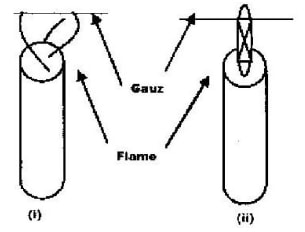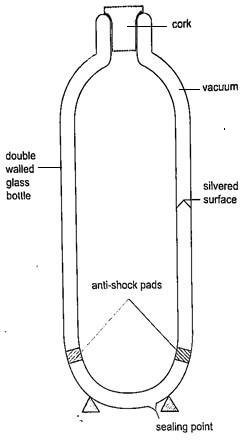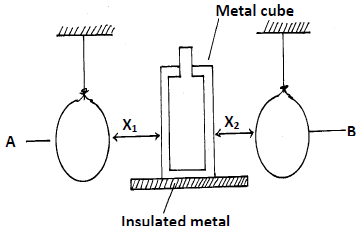Questions
- An electric heater is placed at equal distances from two similar cans A and B filled with water at room temperature. The outer surface of can A is shiny while that of can B is dull black. State with reasons, which of the cans will be at higher temperature after the heater is switched on for some time.
- In the set up shown in figure 4, it is observed that the level of the water initially drops before starting to rise.

Explain this observation. - When a Bunsen Burner is lit below a wire gauze, it is noted that the flame initially burns below the gauze as shown in figure (i), after sometime, the flame burns below as well as above the gauze as shown in figure (ii)

Explain this observation - In a vacuum flask the walls enclosing the vacuum are silvered on the inside. State the reason for this (1 mark)
- Figure 4 shows two identical balloons A and B. The balloons were filled with equal amounts of the same type of gas. The balloons are suspended at distances X1 and X2 from a metal cube filled with boiling water and placed on an insulating material.
Use this information to answers question below- State the mode by which heat travels from the cube to the balloons (1 mark)
- The face of the cube towards A is bright and shiny and the face towards B is dull black. State with reason the adjustments that should be made on the distances X1 and X2 so that the rate of change of temperature in both balloons is the same. (1 mark)
- Temperature scale in clinical thermometer ranges from 35oc to 43oc. Explain.
- State one application of expansion in gases
- Why is it that boiling is not used for sterilization of clinical thermometer?
- Describe ONE advantage and ONE Disadvantage of anomalous behavior of water.
-
- Draw a well labeled diagram of a vacuum flask
- Stating the specific parts in the flask explain how heat loss is reduced through:
- Conduction
- Convection
- Radiation
- In the diagram below the ice remains in solid state for several minutes as heating continues. Explain the phenomenon.
Answers
- Can B is a good absorber of radiation/better absorber of radiation or heat.
- Glass flask expands first (creating more volume for water)
- Water then expands using the tube. - In (i), Gauze conducts heat away temperature above is lower than ignition temperature of the gas.
In (ii) Gauze is hotter than ignition temperature of the gas (Required to ignite it). - To reflect heat outwards or inwards hence reduce heat loss by radiation.
-
- Radiation
- - X2 is made larger than X1
- Since B receives radiation at a higher rate, it must be moved further from source for rates to be equal.
- The clinical thermometer is designed to measure the temperature of human body only. The temperature of human body normally does not go below 35oC or above 43oC. That is the reason why this thermometer has the range 35oC to 43oC
- - used in gasoline pumps.
- used in air balloons. - Maximum temperature measured on a clinical thermometer (43°C) is less than that of boiling water/the thermometer will burst/crack.
- Advantages
- It enables fish to survive in water. Ice being a poor conductor of water.
- Weathering of rocks.
Disadvantages
- Bursting of pipes
- Icebergs which is a danger to ships as navigators cannot see the submerged part. -
-

-
- Heat loss through conduction is minimised by the presence of vacuum in the flask where conduction cannot take place.
- The insulating stopper or cork at the top minimises heat loss by convection.
- Heat loss through radiation is minimised by the layer of the silver coating on the inside of the flask.
-
- When you heat ice, the individual molecules gain kinetic energy, but until the temperature reaches the melting point, they don't have energy to break the bonds that hold them in a crystal structure.
Download Heat Transfer Questions and Answers - Physics Form 1 Topical Revision.
Tap Here to Download for 50/-
Get on WhatsApp for 50/-
Why download?
- ✔ To read offline at any time.
- ✔ To Print at your convenience
- ✔ Share Easily with Friends / Students


